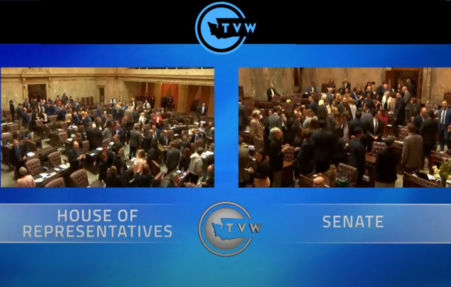Dear Friends and neighbors,
This was a very fast-paced legislative session with some very late nights and marathon floor sessions, including debating bills until sunrise on Sine Die weekend. But it was all worth it because we adjourned right at midnight on April 28! It’s been a decade since the last time the Legislature finished on time in a budget year.
If you’ve never been at a Sine Die ceremony, click on the image below to see the moment when the gavels in both chambers came down for the last time.
 |
This report focuses on the budgets and the bills I prime-sponsored that made their way to the governor’s desk. Since there’s a lot to report on these 105 days, I won’t cover all of it in one newsletter, so expect more content on the important legislation accomplished this session in future updates.
As always, if you want additional information or just to tell me what’s on your mind, please get in touch. Israel and I are back in our district office, at 206-708-6559.
Sincerely,

A Budget that Puts People First
The operating budget pays for many of the operations of our state government, including critical investments in behavioral health, affordable housing, education, and the environment.
 |
Here are some of the highlights in the $52 billion 2019-21 operating budget plan:
To help people in crisis, we are making significant investments (over $450 million) to reform and improve the state behavioral health system by expanding community behavioral health beds and services, and ensuring the stability of state hospitals and the safety of patients and staff.
The $1.5 billion investments we made in K-12 education include additional funding for special education; additional levy assistance for areas with low property values; additional support for paraeducator training, student safety and well-being, guidance counselors. We are also investing nearly $300 million to expand Early Childhood Education and Assistance Program slots and rate increases.
Nearly $1 billion to improve access to higher education and strengthen our workforce by increasing financial aid and student success programs, including Guided Pathways, Opportunity Scholarships and Career Connected Learning.
Other investments include funding toward eliminating the backlog in testing sexual assault kits; strengthening our safety net for our aging population, people with disabilities and the homeless; protecting our Southern Resident Orcas; increasing our response to wildfires and natural disasters; expanding rural broadband; and fully funding the state employee contracts.
For more detailed information on the operating budget, please read this press release.
Transportation Budget Highlights
This budget will allocate more than $9 billion to maintain our transportation infrastructure, support jobs, and address key traffic and transportation problems that affect working families all over the state.
 |
You can find a complete list of projects in this interactive map, but some of the highlights include:
- Improvements for our public transportation system, including bussing infrastructure, from preparing for the SWIFT line to connect Bothell and Paine Field, to electrifying buses in Everett. The budget also invests in the ferry systems at both the Mukilteo and Edmonds terminals, including funding continued electrification of our fleet.
- Road Improvements: Continued work on I-405, revitalization of parts of SR-99 in Edmonds, improving access to Lynnwood City Center, and much more.
- Edmonds Waterfront Connector: Full funding for a crossing over the rail lines from downtown Edmonds to the waterfront to ensure safe access for pedestrians, and serve as a more reliable way for emergency vehicles to respond adequately.
Capital Budget Highlights
The $4.9 billon construction budget we passed with bipartisan support makes important investments in Washington’s future to build public schools, colleges, affordable housing and mental health facilities.
 |
You can look at the full details of the construction budget using the mapping tool. Some of the highlights include:
- $1.1 billion for K-12 public school construction
- $973 million for higher education
- $274 million for construction and renovation of behavioral health facilities
- $585 million for orca and salmon recovery programs
- $175 million for the Housing Trust Fund to increase affordable housing
These are some of the projects happening in our area:
- Mukilteo Promenade: Our Downtown Waterfront Master Plan seeks to create a continuous walkway from Lighthouse Park to Edgewater Beach Park, and the capital budget funds the first phase of that promenade.
- Japanese Gulch: Our proposal includes funding for the daylighting and restoration of the Japanese Gulch. The long-term vision of this project will benefit both salmon and the residents in our region.
- Other investments in our area include shorelines improvements at Meadowdale Beach Park, community fields at Civic Park, and behavioral health investments at Community Health of Snohomish County.
Report on Prime-Sponsored Legislation
There’s a gap in delivering counseling services to provide mental and emotional support to students in community and technical colleges.

My bill, signed by the governor on April 24, creates a task force to examine minimum standards and staffing ratios, as well as best practices for counselors. The goal is to come up with a plan for community and technical colleges to meet the mental health needs of students and staff. About a third of college students in the United States are struggling with hunger and stable housing, and nearly 10 percent are homeless. According to the Snohomish County Point-In-Time Count released this week, in the last year, the percentage of unsheltered young adults, ages 18–24, increased 4.5 percent. I sponsored the House version of a bill the governor is expected to sign soon to address this issue. It will create pilot programs at a handful of colleges and universities, on both sides of the Cascades, to collect data and help students who experience homelessness as well as those who were in foster care when they finished high school.
|

One in seven people in our state are immigrants, and they are an integral part of our communities and workforce. They are often targeted, which makes them feel unsafe and threatens their dignity. But it also destabilizes the workforce of many of our state’s critical industries, including our multi-billion dollar agriculture sector. I sponsored the House version of the Keep Washington Working Act, which was sent to the governor last week, to address these issues. It establishes a statewide policy supporting Washington state’s economy and immigrants’ role in the workplace, and ensures their access to state services. It develops strategies to protect our immigrant workforce, and secure their rights as workers and members of our communities. I also sponsored the House version of the ethnic studies curriculum bill that went to the governor’s desk. The measure requires OSPI to identify and make available ethnic studies materials and resources for middle and high schools. This is important policy because when students of color see their cultures reflected in the classroom, they are more engaged in learning, which leads to academic success. Last year we recognized March 31 as Cesar Chávez Day. César Chávez and Dolores Huerta dedicated their lives to organizing and fighting for safe work places, fair pay, and good working conditions for farmworkers, so I felt it was the right course of action to follow up with a bill recognizing April 10 as Dolores Huerta Day. The governor signed this bill into law on March 21. Read more about this legislation here. While HB 1322, concerning dual language programs in schools did not pass, I was able to secure $1.5 million in the budget to increase the grants, but I will continue working on growing these programs because we have to acknowledge the language assets of multilingual learners.
|

We also managed to get $2 million in the budget to increase the number of counselors in our schools, even though HB 1265 did not pass. The measure was part of a larger focus on school safety because school counselors have positive effects on students, particularly students from low-income families, including increasing graduation rates and reducing disciplinary actions. My bills regarding a youth development workgroup, the building communities fund, and parental improvement certificate stalled in the process, but I am committed to these issues and will continue pushing for them next year.
|
